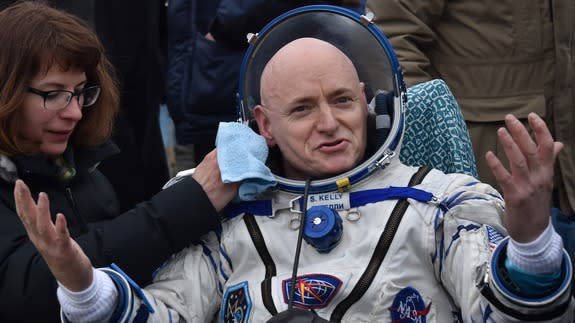Side effects of 340 days in space: burning skin and terrible basketball skills

Coming back to Earth after spending 340 days in space can be a pretty traumatic experience.
Even veteran NASA astronaut Scott Kelly — who just completed his fourth mission to space Tuesday — is having a somewhat tough time adjusting to life back on the planet after living for nearly a year in the weightlessness of the International Space Station.
"Adjusting to space is easier than adjusting to Earth for me," Kelly said during a press conference Friday.
SEE ALSO: This astronaut just spent 340 days in space. Here's why it was worth it.
"There's always a certain amount of soreness and fatigue and that kind of stuff," Kelly said of his state post-landing, comparing it to his earlier six month stay on the Space Station.
"Initially this time coming out of the capsule, I felt better than I did last time, but at some point those two lines have crossed and my level of muscle soreness and fatigue is a lot higher than it was last time."
Kelly is also having a problem with how sensitive his skin is now that he's on Earth.
When Kelly was in space, he had very little contact with chairs and other objects a person on Earth touches for long stretches of time, he now has something like a "burning feeling wherever I sit, or lie or walk," Kelly said.
Aside from the skin and muscle issues, Kelly also mentioned that he's a little worse at playing basketball now that he's back on Earth.
"The first thing I tried to throw on a table, I missed," Kelly said. "I tried to shoot some basketballs yesterday, and I didn't get any of them in the net, not that I'm a good basketball player in general anyway."
This loss of coordination also goes along with a problem some astronauts report when coming back to Earth's gravity: They drop things a lot.
"I don't seem to have a tendency, though, to want to drop things like some people," Kelly said.
"On my first flight that was seven days, I had that tendency to want to let something go, but never again... But definitely throwing things, you tend to underestimate the effects of gravity."
Kelly also said he "grew" about 1.5 inches taller during his stay in space, but he went back to normal height shortly after landing.
This is a documented physical side-effect of spaceflight. The spine stretches in weightlessness, but once an astronaut comes back to the ground, his or her height returns to normal quickly after standing up in Earth's gravity, NASA says.
More research, more analysis
Scientists are hoping to learn a lot more about how Kelly's body changed during his long stay on the Space Station.
When Kelly was still in space, NASA had him draw blood samples at various points in his mission in order to see how his bodily fluids changed over time.
Scott's identical twin brother Mark Kelly, himself a former astronaut, also took part in these kinds of experiments on the ground to serve as a control.
Many of Scott's samples are still up in space, so until they are returned to Earth aboard a SpaceX Dragon capsule in May, scientists won't have a complete picture of how his body changed during the long duration mission.
The experiments conducted by Kelly and his fellow yearlong crew member, Russian cosmonaut Mikhail Kornienko, were designed to look at their eye health, fluid distribution, genetics, psychology and other physical and emotional indicators.
In all, it will probably take about a year to collect and analyze all of Scott and Mark's samples, NASA scientists said during the press briefing.
Researchers are also continuing to collect samples and run tests on the twins now that Kelly is back on the ground to see how he adjusts to life on the planet.
All of this science is aimed at helping NASA prepare for what astronauts may face on a longer trip to and from Mars. Such a trip, including time spent on the red planet, could take more than one to two years.
Life on Mars
Testing Kelly just after he landed back on Earth was an important part of these investigations.
When astronauts arrive on the surface of the red planet after a long journey in weightlessness, they won't have anyone on the other planet to help them out of their capsules.
Those Martian explorers will be on their own once they get there.
For what it's worth, Kelly thinks that he probably could have managed to get out of the capsule on his own and explore Mars after his time in weightlessness, judging by how he felt landing in Kazakhstan while nested inside the Soyuz spacecraft.
"Mars has less gravity, which is helpful as well," Kelly added.
Just after landing, Kelly and Kornienko were taken into a medical tent at the landing site for some field tests.
The two space explorers were tested for agility and coordination in order to see how well they bounced back from living in microgravity for 340 days.
Kelly seems to have done well at his tests, which may bode well for NASA's future Martian ambitions.
"What I've been told is that he completed all the testing, which is in itself a real accomplishment because it's a lot work to do immediately after a very strenuous and I think harrowing episode, when you land in the Soyuz," said NASA's John Charles, the associate manager for international science within NASA's human research program.

